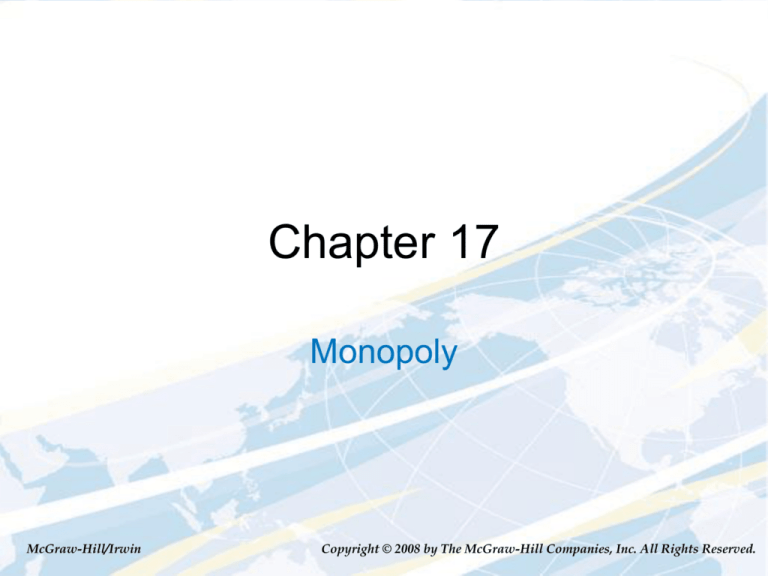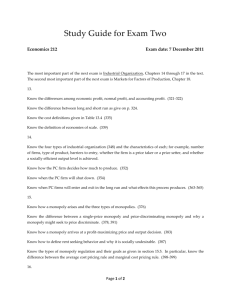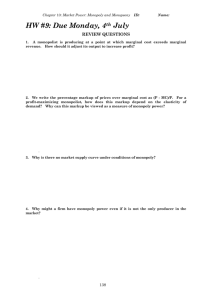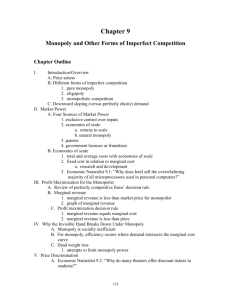
Chapter 17
Monopoly
McGraw-Hill/Irwin
Copyright © 2008 by The McGraw-Hill Companies, Inc. All Rights Reserved.
Main Topics
Market power
Monopoly pricing
Welfare effects of monopoly pricing
Distinguishing monopoly from perfect
competition
Nonprice effects of monopoly
Monopsony
Regulation of monopolies
17-2
Market Power
In many situations, competition is not intense
A firm has market power when it can profitably charge
a price that is above its marginal cost
Most firms have some market power, though it may be
very slight
Depends on whether their competitors’ products are close
substitutes
Two market structures in which firms have market
power:
A monopoly market has a single seller
An oligopoly market has a few, but not many, producers
Determining what is and is not a monopoly market can
be trickier than simple definitions might suggest
17-3
How Do Firms Become
Monopolists?
Firms get to be monopolists in various ways:
Government grants a monopoly position to a firm
(cable TV companies in local communities, drug
patents)
Economies of scale (concrete supply in a small
town)
Being first to produce a new product (iPod)
Owning all of an essential input (De Beers diamond
producer)
Many of these ways of initially capturing market
power tend to erode over time
17-4
Figure 17.1: Scale Economies
and Monopoly
Monopolist can make
a profit because AC
lies below the
demand curve at
some quantities
Two firms cannot
make positive profits
AC lies above Dhalf for
all quantities
17-5
Monopoly Pricing
Monopolist will choose the price that maximizes its
profit, given the demand for its product
Whenever the firm’s profit-maximizing sales quantity is
positive, marginal revenue equals marginal cost at that sales
quantity
Marginal cost curve applies as usual
Need to examine the shape of the marginal revenue
curve
Recall that a firm’s marginal revenue curve captures
the additional revenue it gets from the marginal units it
sells, measured on a per-unit basis
17-6
Marginal Revenue for a
Monopolist
An increase in sales quantity (DQ) changes revenue in two ways
Firm sells DQ additional units of output, each at a price of P(Q),
the output expansion effect
Firm also has to lower price as dictated by the demand curve;
reduces revenue earned from the original (Q-DQ) units of output,
the price reduction effect
The overall effect on marginal revenue is:
DP
Q
MR PQ
DQ
So the price reduction effect makes the monopolist’s marginal
revenue less than price
17-7
Figure 17.2: Marginal Revenue
and Price
17-8
Sample Problem 1 (17.2):
Suppose that Noah and Naomi have a
monopoly in the garden bench market.
Their weekly demand is D(P) = 500 – 4P.
What is their marginal revenue when they
sell 100 garden benches a week? Graph
their inverse demand and marginal
revenue curves.
Monopoly Profit Maximization
When a monopolist maximizes its profit by selling a
positive amount, its marginal revenue must equal its
marginal cost at that quantity
If marginal revenue exceeded marginal cost the firm would be
better off selling more
If marginal revenue were less than marginal cost the firm would
be better off selling less
Two-step procedure for finding the profit-maximizing
sales quantity
Step 1: Quantity Rule
Identify positive sales quantities at which MR=MC
If more than one, find one with highest profit
Step 2: Shut-Down Rule
Check whether the quantity from Step 1 yields higher profit than
shutting down
17-10
Figure 17.4: Monopoly Profit
Maximization
17-11
Markup
A monopolist facing a downward sloping demand
curve will set its price above marginal cost
Firm in a perfectly competitive market sets price equal to
marginal cost, meaning that the firm has no market power
Extent to which price exceeds marginal cost is a
measure of monopolist’s market power
A firm’s markup, price-cost margin, or Lerner
index equals the difference between its price and its
marginal cost, as a percentage of its price
P MC
1
d
P
E
17-12
Markup
A monopolist’s markup at its profit-maximizing
price always equals the reciprocal of the
elasticity of demand, times negative one
The less elastic the demand curve, the greater
the firm’s markup over its marginal cost
When demand is less elastic, raising the price
is more attractive because fewer sales are lost
This also implies that demand must be elastic
at the profit-maximizing price
17-13
Sample Problem 2 (17.4):
Suppose KCC has faces an annual
demand function Q = 16,000 – 200P,
where P is the price, in dollars, of a cubic
yard of concrete and Q is the number of
cubic yards sold per year. Its marginal cost
of $20 per cubic yard and an avoidable
fixed cost of $100,000 per year. What is its
profit-maximizing sales quantity and price?
Welfare Effects of
Monopoly Pricing
By charging a price above marginal cost, the
monopolist makes consumers worse off than under
perfect competition
Consumers who buy the product pay more for it
Some who would have bought it under perfect competition will
not buy it at the higher price
Welfare effects of monopoly pricing:
Firm gains
Consumers lose
Deadweight loss incurred
Deadweight loss from monopoly pricing is the amount
by which aggregate surplus falls short of its maximum
possible level, which is attained in a competitive
market
17-15
Figure 17.5: Welfare Effects of
Monopoly Pricing
17-16
Distinguishing Monopoly from
Perfect Competition
Existence of more than one firm in a market
does not guarantee perfect competition
How can we tell whether multiple firms in a
market are behaving like price takers or
colluding and acting like a monopoly?
Easy to answer if we could observe marginal costs
and compare to price
Monopolists and perfectly competitive
industries behave differently in responses to
changes in demand and changes in costs
17-17
Response to Changes in Demand
Monopolist’s profit-maximizing price depends
on elasticity of demand
Price in perfectly competitive market depends
on level of demand
If elasticity of demand changes but level of
demand does not, provides a way to
distinguish between market structures
Can investigate this through data collection
over time and statistical analysis
17-18
Figure 17.7: Response to a
Change in Demand
17-19
Response to Changes in Cost
How do monopolies and perfectly competitive markets
differ in their response to changes in costs?
Consider the case of a marginal cost increase by a
given amount at every level of output
Example: a specific tax, T, on firms
The pass-through rate is the increase in price that
occurs in response to a small increase in marginal
cost, measured per dollar of increase in marginal cost
In a competitive market, the pass-through rate is never
greater than one
The monopolist’s pass-through rate depends on the
shape of the demand curve
Can be greater than one with a constant-elasticity demand
curve
17-20
Nonprice Effects of Monopoly:
Product Quality
Product quality is a decision firms make
Raising a product’s quality increases the consumer’s
willingness to pay
Producing a higher-quality product usually costs more
The firm must decide whether the extra benefit is worth the
extra cost
How does the quality provided by a monopolist
compare to the level that would maximize aggregate
surplus?
If different consumers value quality differently, the
monopolist may not choose to offer the quality that
maximizes aggregate surplus
May over- or under-produce quality
17-21
Product Quality: Car Wash Example
Suppose the only car wash in town is deciding whether to provide
hand washing
Without hand washing the firm maximizes profit by selling 100 washes at
$15 each, profit is $1,000
Hand washing costs $5 more per wash
Consumers whose willingness to pay is above $22 value a car wash
$15 more if done by hand
All other consumers value a hand wash $5 more
With hand washes, firm’s profit-maximizing quantity is 100 washes at
$20 each, with profit of $1,000
Aggregate surplus:
Without hand washes: $1,500
With hand washes: $1,800
Firm is indifferent between providing and not providing the higher
quality product
If cost of hand washing were $5.01, monopolist would choose not to
provide it even though aggregate surplus would be greater with it
17-22
Figure 17.9: Monopolist and
Product Quality
17-23
Sample Problem 3 (17.20):
The only gas station in a small town sells both
regular and premium gasoline. The weekly demand
functions for the two gasolines are:
QReg = 10,000 – 1,000PReg +50PPrem and
QPrem = 350 + 50PReg – 100PPrem
where the quantities are measured in gallons and
prices in dollars per gallon. Are these products
substitutes or complements? If the price of regular
gas is $3.00 per gallon, its marginal cost is $2.95,
and the marginal cost of premium is $3.05, what is
the profit-maximizing price of premium gas?
Nonprice Effects of Monopoly:
Advertising
Spending on advertising is another important decision for many
firms
Because the monopolist’s marginal cost is less than the price,
each additional sale increases its profit
Firms in perfectly competitive markets have no individual incentive
to advertise
Each firm perceives itself as capable of selling as much as its desires
at the market price
Marginal benefit of advertising equals the increase in sales times
the firm’s profit on additional sales
At the profit-maximizing level of advertising, this marginal benefit
must equal the extra dollar expended
For a monopolist, the ratio of the amount spend on advertising to
the firm’s total sales revenue, the advertising-sales ratio, equals
the advertising elasticity divided by the elasticity of demand, times
negative one
17-25
Nonprice Effects of Monopoly:
Investments
Firms can also make investments in an effort to become a
monopolist
Example: cable TV firms lobbying government officials to award them
franchises
If firms compete to become a monopolist, they will spend up to the
full monopoly profit less avoidable fixed costs
If spend on socially wasteful things (e.g., golf outings for local
officials) the loss from monopoly may be larger than deadweight loss
and include all monopoly profit
Rent seeking is socially useless effort devoted to securing a
monopoly position
Welfare effects of monopoly need not always be so bad
Expenditures firms make to gain monopoly positions can be socially
valuable (e.g., R&D spending in the search for patentable drugs)
17-26
Monopsony
Market power isn’t limited to the sellers of a product: it
also can be held by buyers
A monopsony market has a single buyer
Analysis of monopsony parallels the analysis of
monopoly
A monopsonist faces an upward-sloping supply curve
By lowering the quantity he buys, can pay less
Monopsonist can think either in terms of what price to
pay or in terms of how many units to employ
17-27
Marginal Expenditure
A monopsonist’s marginal expenditure, ME, is the
extra cost per marginal unit of an input
Consider a small city in which the hospital is the only
employer of nurses
The hospital’s marginal expenditure has two parts
The input expansion effect: the marginal nurse costs W
Given the upward-sloping supply curve, the hospital must
increase the wage by (DW/DQ) to hire another nurse
Since the hospital must pay Q nurses this higher wage, the
wage increase raises nursing costs by (DW/DQ) Q
So ME is larger than W since the total effect is:
ME W DW / DQQ
17-28
Monopsony Profit Maximization
The monopsonist’s profit-maximizing choice
equates its marginal benefit with its marginal
cost
Maximizes its profit by choosing the quantity at
which its demand and ME curves cross
Result is lower price and quantity than if the
firm was a price taker
Can solve for the equilibrium algebraically by
setting marginal benefit equal to marginal
expenditure and solving for quantity
17-29
Figure 17.10: Monopsony
Profit-maximizing
outcome:
Occurs where
marginal expenditure
curve crosses the
demand curve
Firm hires 200 nurses
Wage is $50,000
Deadweight loss is
red-shaded area
17-30
Welfare Effects of
Monopsony Pricing
Like with monopoly, monopsony price setting
creates deadweight loss
Monopsonist uses too little of the input
Potential net benefits from the input are lost
Deadweight loss is created between the
marginal benefit and market supply curves
See the red-shaded region in Figure 17.10
Can compute the dollar value of the
deadweight loss using algebra
17-31
Sample Problem 4 (17.15):
The Happyland Hospital is a monopsonist
employer of nurses in the small city of Happyland.
The supply function of nurses is S(W) = 0.1W –
100, where W is the nurses’ weekly wage. What is
the hospital’s marginal expenditure, ME? If the
hospital’s marginal benefit is $2,000 per week no
matter how many nurses it hires, what is the profitmaximizing number of nurses for the hospital to
hire? What will the nurses’ wage be? What is the
deadweight loss?
Regulation of Monopolies
Deadweight loss from monopoly pricing provides a
justification for government intervention
Government actions that keep prices closer to marginal
cost can protect consumers and increase economic
efficiency
Intervention can take many forms
Antitrust legislation (see Chapter 19)
Direct regulation of prices
Price regulation not common in U.S. today
More prevalent in the past
Still used for electricity, natural gas, local telephone service
More common in some other countries
17-33
Why Are Some Monopolies
Regulated?
Regulation arises out of political pressure and
economic concern about market dominance
When governments create monopolies they may then
regulate them to deal with the negative consequences
May create a monopoly to ensure that goods are
produced at least cost
A market is a natural monopoly when a good is
produced most economically through a single firm
Average cost falls as quantity increases
Second firm may enter but this would cause costs to rise
Government can designate one firm to be the provider
Institute price regulation to protect consumers
17-34
Figure 17.11: A Natural Monopoly
17-35
First-Best vs. Second-Best Price Regulation
Under regulation, ideally prices will be set at the
competitive price
Price at which demand and supply curves intersect
Aggregate surplus will be maximized
First-best solution to problem of price regulation
Two problems with achieving this lead to second-best
regulation
Regulator may not know the firm’s marginal costs
First-best solution would cause the monopolist to lose
money
If P < AC
Best the regulator can do is set a price that makes
aggregate surplus as large as possible, allow the firm to
break even
Set P = AC
17-36








